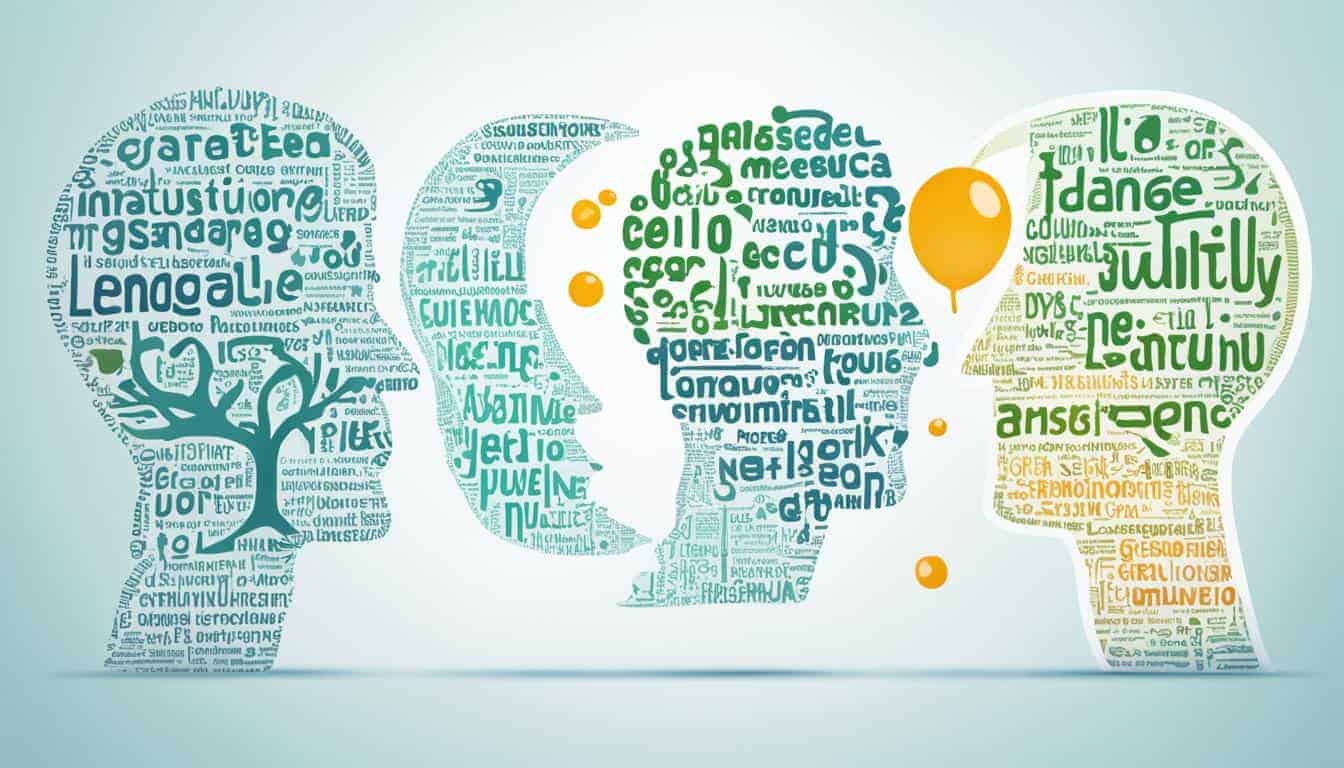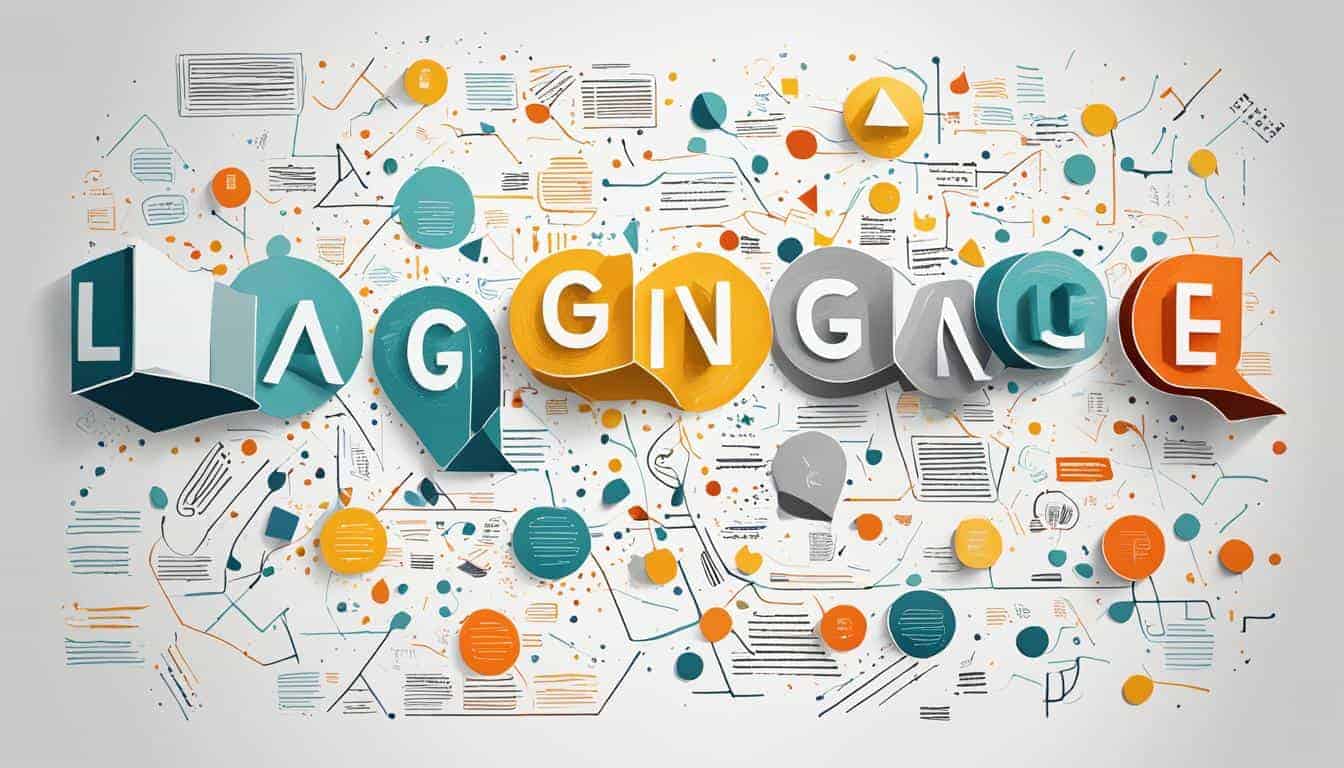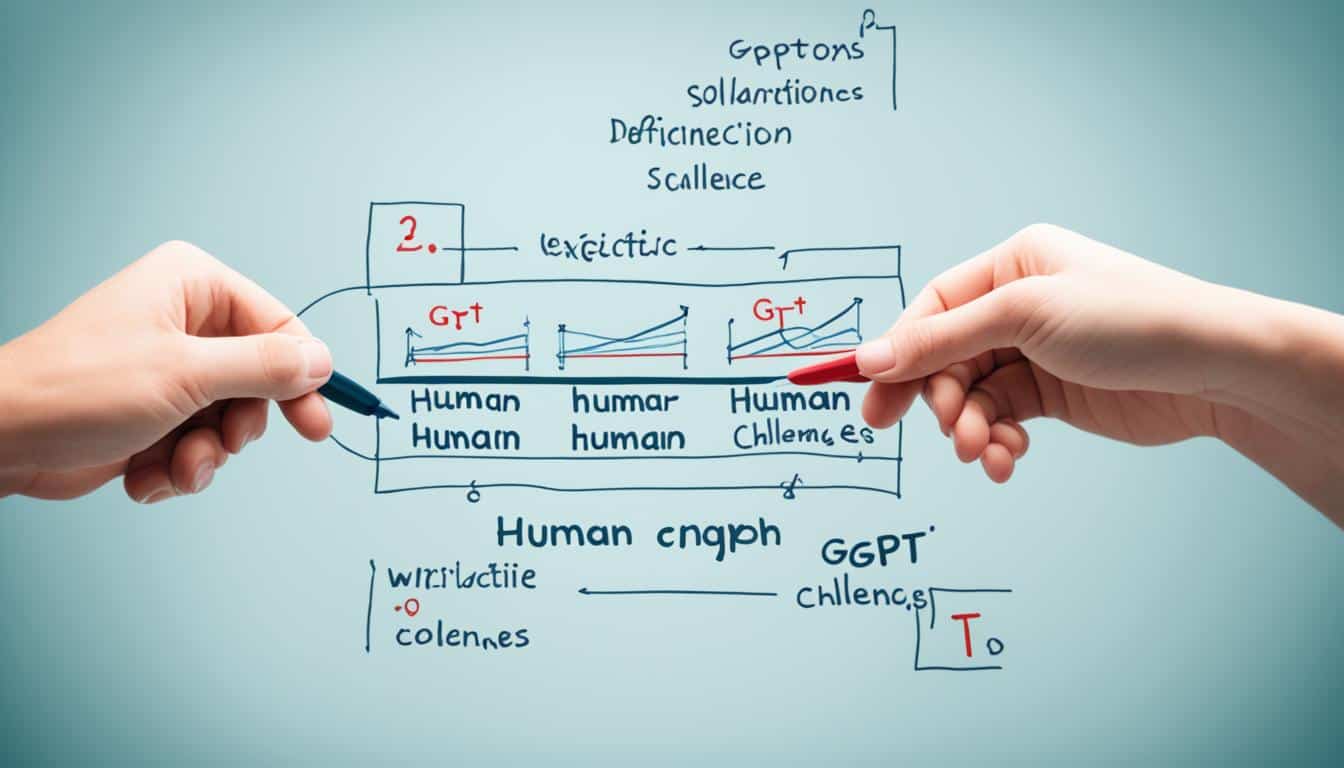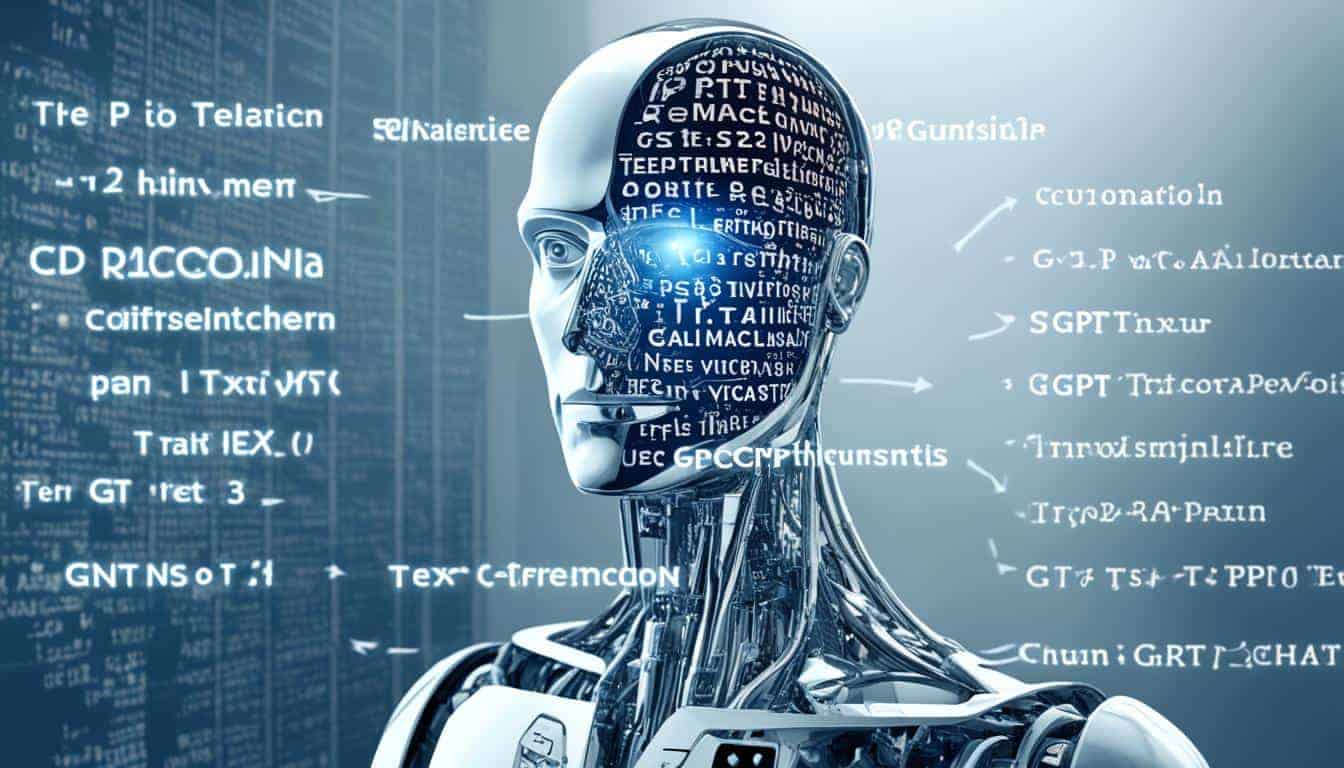GPT-3 Vs Human Text Detection: Comparing Challenges

Did you know ChatGPT can write essays better than humans? That’s how fast AI is getting better. Now it’s hard to tell AI from human written text.
I’ve been following AI text generation closely. It’s amazing how fast these technologies are evolving. GPT-3 and other big language models are making us think about the future of writing. We need good ways to tell AI from human text.
The battle between AI text generators and detection tools is really fun. As AI gets better, so do the ways to spot it. It’s like a game where both sides are always trying to outdo each other.
In this post we’ll look at the main differences between GPT-3 and human writing. We’ll discuss the challenges in detecting AI text and the ethics of it. We’ll also cover the latest ways to tell AI from human written content. This includes using perplexity and stylometric analysis.
Key Takeaways
ChatGPT can write essays better than human writers
GPT-4 beats GPT-3 in structure, complexity and vocabulary
AI and human writing styles differ in sentence structure and complexity
Current AI text detectors are inaccurate and unreliable
Ethical issues in AI text detection include privacy and bias
Introduction to AI-Generated Text
The rise of artificial intelligence (AI) has led to significant advancements in natural language processing (NLP) and the development of large language models. These models have the ability to generate human-like text, making it increasingly difficult to distinguish between AI-generated and human-written content. AI-generated text has become a topic of interest in various fields, including education, marketing, and journalism. Understanding the characteristics and traits of AI-generated text is essential for developing effective detection methods and ensuring the authenticity of online content.
Overview of AI Text Evolution
The evolution of AI-generated text has been rapid, with significant improvements in recent years. The development of large language models, such as GPT-3 and ChatGPT, has enabled the creation of highly sophisticated and human-like text. These models are trained on vast amounts of data, including books, articles, and online content, which allows them to learn patterns and relationships in language. The result is AI-generated text that is often indistinguishable from human-written content.
Importance of Understanding AI Text
Understanding AI-generated text is crucial for several reasons. Firstly, it can help to detect and prevent the spread of misinformation and disinformation online. Secondly, it can assist in identifying and addressing issues related to academic integrity and plagiarism. Finally, it can enable the development of more effective content creation tools and strategies that leverage the strengths of both human and AI-generated content.
GPT-3 and AI Text
I’ve been following natural language processing and machine learning for a while now. GPT-3 has changed the way we think about writing. This AI can write text that sounds like a human wrote it and we are wondering about the future of writing.
What is GPT-3?
GPT-3 is the top AI system that uses deep learning to generate text. It’s trained on a massive amount of training data, including both labeled and unlabeled datasets, so it can write content that makes sense and fits the context. How it understands and mimics human language is crazy.

AI-generated content
AI text generators have taken off fast. ChatGPT which uses GPT-3 tech got 100 million users in 2 months. This fast growth of content generated by AI has people excited and worried, especially in fields like academic publishing.
Why detect AI-written text
It’s important to detect AI text to keep content real. A study found GPT-3 made tweets that were often seen as real. This shows how hard it is to tell human-written from AI-written content. As AI gets better, finding ways to detect AI text is more important to keep human work valuable.
Characteristics of AI-Generated Text
AI-generated text has several distinct characteristics and traits that can be used to identify it. Some of the most common features include:
Common Features and Traits
Fluency and coherence: AI-generated text is often highly fluent and coherent, with a natural flow and structure.
Lack of errors: AI-generated text tends to be error-free, with no grammatical or spelling mistakes.
Repetition and redundancy: AI-generated text may repeat certain words or phrases, or use redundant language.
Lack of emotion and personality: AI-generated text often lacks the emotional tone and personality that is characteristic of human-written content.
Factual errors: AI-generated text may contain factual errors or outdated information.
Unusual choice of words: AI-generated text may use unusual or uncommon words or phrases.
Lack of context and relevance: AI-generated text may lack context and relevance, or provide irrelevant information.
Lack of tone and style: AI-generated text tends to be bland and uninteresting, lacking the unique tone and style of human-written content.
These characteristics and traits can be used to identify AI-generated text and distinguish it from human-written content. However, it is essential to note that AI-generated text is becoming increasingly sophisticated, and the differences between human and AI-generated content are becoming less pronounced.
The Basics of Language Models and Text Generation
Language models are key to natural language processing and natural language generation. They learn to guess the next word in a sentence by looking at lots of text. This has changed how we talk to machines, making text generation more like human speech.
GPT-3 is a big deal in language models. It has over 175 billion parameters. This huge network can do many tasks, like writing articles or making code. It’s amazing at understanding context and writing clear text.

AI text generation has grown a lot. Now, models can make memes, translate languages, and help with medical diagnoses. They learn from different types of data, like the web and encyclopedias. This lets them write about almost any topic.
But these advances bring up new issues. It’s getting hard to tell AI-generated from human-written text. This makes us think about who should get credit for content and the future of writing.
Key Differences Between GPT-3 and Human Writing
I’ve looked into how AI and human writing differ. These differences are important for understanding text. Let’s talk about what I found.
Linguistic Patterns and Structures
AI texts often have simple structures. Language analysis reveals that GPT-3 uses short sentences and easy words. Humans write with varied sentence lengths and complexities. This is a big clue to spotting AI or human writing.
Vocabulary Usage and Diversity
Humans are great at choosing words. We add our feelings and experiences to our writing. This makes our language diverse and creative. AI tries to do this but often uses the same phrases and lacks human depth.

Contextual Understanding and Coherence
Humans are good at language understanding, especially in terms of context and keeping a story flowing. We add stories and opinions that fit the topic. AI knows a lot but can’t always connect it well to the topic. This is key in telling human from AI writing.
Knowing these differences helps us value human writing more. It also shows what AI can and can’t do. As technology gets better, telling human from AI writing gets harder. This makes knowing the real source of text more important.
AI text detection is facing big challenges. The line between human and machine-generated content is getting blurry. This makes it hard for researchers and educators to tell the difference.
A recent study looked into these issues. It compared GPT-3.5 and GPT-4 with human writing. The results were surprising. Tools found GPT-3.5 content easier to spot than GPT-4. This means newer AI models are harder to detect.

But the tools also had trouble with human texts. They often thought human writing was AI-generated. This is a big worry for plagiarism detection systems. It makes it hard to trust these systems for checking original work.
The study showed some tough numbers. OpenAI’s tool correctly spotted only 26% of AI text. It wrongly thought 9% of human writing was from a machine. Some companies say their tools work well, but real tests show different results.
As AI writing gets better, detecting it gets harder. This game of cat and mouse makes us wonder: Can we really tell human from AI text?
Detection Techniques and Methodologies
Spotting AI-generated text is getting harder. AI language models like GPT-3 are making it tough for old detection methods. Let’s look at new ways to tell human from machine-written content.
Perplexity-based Approaches
Perplexity measures how surprised a language model is by a text. AI texts often have lower perplexity scores, meaning they’re more predictable. This helps spot patterns that seem too perfect for humans.
Machine Learning Classifiers
Machine learning algorithms are key in classifying text. These systems check different writing features to tell AI from human texts. A study used 20 features and an XGBoost classifier. It got 99% right in telling human from ChatGPT texts.
Stylometric Analysis
Stylometric analysis looks at writing style. It checks sentence complexity, punctuation, and vocabulary. This method finds small differences between human and AI writing. For example, AI uses more common words, while humans often make typos and use rare words.
But, detecting AI-generated content is still hard. A study at Cornell University found people thought fake news from GPT-2 was real 66% of the time. Tools like the Giant Language Model Test Room (GLTR) try to help spot AI texts. But, as AI gets better, so must our ways of detecting it, building on previous research to improve accuracy.
Limitations of Existing Detection Tools
Current AI text detection tools have big problems. They often can’t tell the difference between human and AI-written text, especially with non-native English speakers. This leads to mistakes in identifying human or AI-created content.
How well these tools work depends on the prompts used to make AI text. Some prompts can fool these detectors, making it tough to find AI-generated content. As AI gets better, these detection tools must keep up with updates.
About 20% of AI-generated texts can’t be caught by detectors. And, 25% of texts written by humans are wrongly marked as AI-created. This shows how hard it is for current tools to classify text correctly.
Teachers in schools struggle to find reliable ways to spot AI-generated reports. Businesses trying to find AI-created SEO content in marketing articles also face challenges. There’s a big need for better AI detection tools, but what we have now doesn’t quite cut it.
AI Text Detection Ethics
I’ve been thinking about the ethics of AI text detection. As AI generated content grows we have new challenges in keeping AI ethics and academic integrity. The use of detection tools worries us about privacy and fairness.
Privacy
When we send texts for analysis we share personal data. So we wonder how that data is stored and used. I worry about the misuse of our content and need for strong data protection.
Detection Bias
Detection bias is a big issue in AI text analysis. Researchers at Stanford found tools are less accurate for those who speak English as a second language. This can unfairly affect some students and researchers. We need to fix these biases so everyone is treated fairly.
Academic Integrity
The rise of AI writing tools has made academic integrity complicated. Turnitin says it can detect AI written text with 97% accuracy but other studies show lower rates. This can lead to false accusations of cheating. We need to find a balance to protect students from unfair penalties while maintaining academic standards.
We need to tackle this. Better guidelines and research. Transparency is the answer to this and AI ethics and academic integrity.
Future Developments in AI Text Detection
AI is changing how we make and find text. Models like ChatGPT have made AI content more advanced. The future of finding text with AI is exciting and a bit tricky.
Studies now show how good AI tools are at finding AI-made texts. Originality.ai was 100% accurate, and ZeroGPT was 96%. These results are good, but we can do better. Researchers say we need better tools to stop AI misuse.
In the future, AI for finding text will get much better. New tools will use many methods to be more accurate. They must keep up with changing language models. Working together, AI makers and scholars can create good, fair ways to detect AI text.
Soon, we might have standard tests for AI detection in schools. This could help deal with cheating worries as AI writing gets better. As we go forward, finding a balance between new ideas and responsible use is key for AI text detection’s future.
Looking back, ai text generation has come a long way. Now 51% of K-12 teachers and 27% of professionals use AI writing tools. We’re moving fast into the future of writing.
This is having a big impact on academic publishing and work communication. We’re still figuring it out.
One big problem is how to detect ai generated text. It’s hard because ai is getting better at writing text that looks real. This is making academic publishing dishonest.
In the end the gap between human and ai written content will get smaller. Then we’ll be talking about who gets credit. We need to keep writing human.






